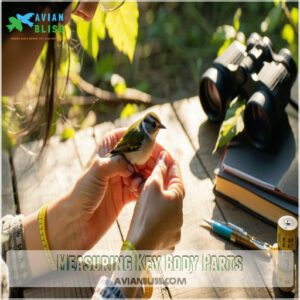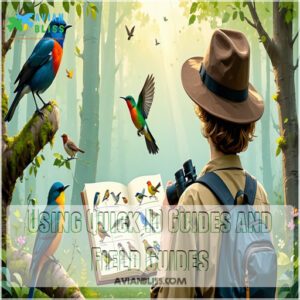This site is supported by our readers. We may earn a commission, at no cost to you, if you purchase through links.

Compare them to objects you know—like a hummingbird’s tininess (under 5 inches) versus an ostrich’s massive bulk.
Study proportions: short tails, long legs, or distinct body shapes can set species apart.
Medium-sized birds often boast noticeable feather patterns, while small birds (5–9 inches) and very small ones tend to flash vibrant plumage.
Use nearby objects for perspective, and sharpen your estimate over time.
Focus on silhouettes, beak shapes, and wing length for added clues.
Want to step up your game?
Habitat and behavior often hide the final answer.
Table Of Contents
- Key Takeaways
- Bird Size Categories
- Judging Bird Size
- Body Parts and Key Details
- Identifying Birds by Size and Shape
- Common Bird Identification Mistakes
- Advanced Bird Identification Techniques
- Frequently Asked Questions (FAQs)
- How do I identify a bird?
- How do you know if a bird is a real bird?
- How do you identify a medium sized bird?
- What if I don’t know the size of a bird?
- How do you estimate the size of a bird?
- How do researchers identify avian dimensions?
- How can I tell what bird I have?
- Is there a website to identify birds?
- What is the best free bird identification app?
- What is the bird app that identifies birds?
- Conclusion
Key Takeaways
- Size matters: You can identify birds by grouping them into size categories, from tiny hummingbirds to massive ostriches.
- Look for proportions: Study the bird’s silhouette, beak shape, wing length, and tail shape. These features provide important clues about the bird’s species.
- Habitat and behavior: Pay attention to the bird’s environment and actions. This can help you narrow down the possibilities and identify the bird more easily.
- Practice makes perfect: The more you bird-watch, the better you’ll become at estimating sizes and recognizing different species. Use field guides and apps to help you improve your skills.
Bird Size Categories
You can group birds into size categories to make identifying them easier, from tiny hummingbirds to massive ostriches.
Knowing where a bird fits helps you narrow down possibilities fast, even if your size estimate isn’t perfect, which involves understanding the bird’s size in relation to others, like ostriches.
Largest Birds: Characteristics and Examples
Ever spotted a bird so big it seemed unreal?
The largest birds boast impressive wingspans and massive bodies that make them hard to miss.
Think herons, eagles, and swans, towering at 25–39 inches with large feathers and fascinating flight patterns.
These giants include some of the largest flying birds on Earth.
These giant species thrive in diverse bird habitats like wetlands or mountains.
For instance, the wandering albatross soars on a 12-ft wingspan!
A quick bird size comparison or a peek at a bird size chart shows just how unique these large bird types are.
It’s incredible, isn’t it?
Medium-Sized Birds: Description and Identification
Medium-sized birds strike a balance between size and adaptability, making them easier to spot if you know where to look.
Keep these in mind:
- Feather Patterns: Watch for standout bird plumage and unique wing tips.
- Beak Shapes & Tail Feathers: Shape and length aid identification.
- Habitat: They frequent woodlands, wetlands, and backyards—perfect for quick bird size comparison!
They can be found by applying the knowledge of these characteristics to locate them in their natural environments.
Small Birds: Distinct Features and Groups
Spotting small bird species is like uncovering hidden gems in your backyard or nearby woods.
These feathered friends, often 5 to 9 inches, captivate with their rapid movements and vivid feather patterns.
Look for vibrant warblers, sprightly sparrows nesting in shrubs, or chickadees flaunting their unmistakable black caps.
Pay attention to bird beak shapes—sparrows have stout bills for seeds, while warblers sport slender ones for insects.
Understanding their flocking behavior during fall or small bird migration bursts in spring gives you seasonal clues.
With a simple bird size guide, observing their unique nesting habits in tree cavities or bushes can be both rewarding and essential for effective bird identification by size!
Very Small Birds: Examples and Unique Traits
Very small birds, under 5 inches, are tiny marvels with distinct traits.
Take hummingbirds, for instance—they hover like mini-drone experts thanks to unique wing anatomy.
Their energy-packed diet of nectar fuels their fast-paced lives.
Spot these feathered gems by noting:
- Beak structure suited for nectar feeding.
- Feather coloration shimmering in sunlight.
- Tiny bird characteristics like rapid, darting movements.
Master bird size guides to sharpen your skills!
Judging Bird Size
You can estimate a bird’s size by comparing it to familiar species or nearby objects. Paying attention to its silhouette, proportions, and key body features helps refine your guess.
Silhouettes and Shape
Spotting bird silhouettes is like reading their shadowy signatures.
A hawk’s wide wings scream power, while a heron’s long neck stands out mid-flight.
Form recognition reveals posture—tight-winged falcons dive fast, unlike soaring eagles.
Study bird profiles in motion, focusing on size and shape.
These visual cues can turn shadows into vivid clues for mastering bird identification by shape.
Using Known Birds as a Reference
When identifying birds, use known birds as your reference points.
Spot a bird you recognize, then compare its size to the mystery bird.
For a thorough guide to avian sizes, explore various bird species by size.
This trick simplifies field observations.
- Pick a reference bird: Think of common species like robins or crows.
- Note differences: Look for larger or smaller size cues.
- Repeat during observations: Consistent use sharpens your size estimation skills.
Measuring Key Body Parts
Ready to sharpen your bird ID game? It’s time to get specific by measuring key body parts.
This bird measurement guide helps you spot subtle but telling details. Pay close attention to beak analysis—is it hooked, slender, or stubby? A hawk’s curved beak screams predator, while a finch’s conical shape hints at seed munching.
Next, try feather inspection. The length and shape of primary feathers can signal flight style. Wing measurement matters, too. Short, rounded wings might belong to a forest bird, while long ones suggest a soaring species.
Don’t skip tail length—long tails bring agility, like in a magpie. Finally, assess body proportions: is the head oversized or the legs extra long? Understanding bird size shapes is essential for accurate identification.
These practical tips will fine-tune your bird size measurement skills in no time.
Comparing to Nearby Objects
When figuring out the size of birds, comparing them to nearby objects is an easy and effective trick.
A park bench, a lamppost, or even a tree branch makes a great visual reference for size estimation.
This approach works like a charm, especially when you’re struggling to judge distance.
Think of it as bringing a bird size chart to life in the field.
Try these tips for relative measurements:
- Compare the bird’s wingspan to the width of a nearby fence or branch.
- Use simple objects like rocks or leaves as consistent object sizing tools.
- Match the bird’s height against taller landmarks, like signs.
- Keep a mental bird measurement guide for common surroundings you know well.
These small adjustments refine your bird size comparison skills.
Body Parts and Key Details
Spotting a bird’s key features, like its bill, tail, or wing shape, can quickly narrow down your options.
Pay close attention to these details, as they often hold the secret to identifying birds with precision.
Bill Shape and Size
Decoding a bird’s bill shape is like deciphering its survival secrets.
From the nut-cracking finch to the insect-snagging flycatcher, their beak structure is tailor-made for daily life.
Here’s how to use it for identification:
- Notice bill curvature—straight, curved, or hooked?
- Observe muzzle shape and nostril size—tiny details reveal diet clues.
- Pair bill shape with bird size categories, wingspan, and overall proportions to match its habitat and habits.
Tail Shape and Wing Shape
The aerial signature of each bird tells a unique story through its tail and wing shapes.
Your bird field guide will show how feather patterns create distinctive flight silhouettes – from the deeply forked tails of nimble swallows to the broad, soaring wings of majestic hawks.
The wing tips and aerodynamic shapes reveal flight styles: pointed for speed, broad for gliding.
The shapes and styles are crucial for identification, as seen in the table below.
This information, including references such as, helps in understanding the various flight styles and characteristics of different bird species.
Head Shape, Neck Length, and Body Shape
Looking at a bird’s head shape and body form tells you more than you’d think.
Each species has unique proportions – some sport large domes like cardinals, while others have sleek profiles like kingfishers.
Head size in birds varies widely, from tiny warbler heads to massive eagle crowns.
Watch their neck posture too – it’s like a signature move, from the S-curve of herons to the straight stance of woodpeckers.
Leg Length and Primary Feathers
The secret language of leg proportions and primary feathers reveals vital bird identification clues.
You’ll notice how leg length matches hunting style – herons wade on long legs while songbirds perch on shorter ones.
A bird’s wing structure depends on its primary feathers, which bend and flex during flight.
These feathers work like nature’s high-tech tools, helping birds achieve different flight mechanics – from the swift dives of falcons to the graceful glides of seabirds.
Identifying Birds by Size and Shape
You’ll find that a bird’s size and shape offer the most reliable clues for quick identification in the field, even when colors aren’t clear or lighting is poor.
When you’re trying to identify a bird, start by comparing its overall size to familiar birds you know well, like robins or crows, then notice its unique body shape and posture.
Relying on Silhouettes and Posture
Mastering bird silhouettes against the sky reveals key Visual Cues like a detective’s clues.
Study each bird’s unique Posture Analysis – hawks display broad wings while swallows show forked tails.
Flight Patterns tell stories: soaring birds paint different Shadow Identification pictures than darting ones.
Practice identifying birds by silhouette using wing shapes and tail positions for quick recognition.
Bird Profiles become nature’s signatures.
Considering Size and Body Proportions
A bird’s mystery unravels when you focus on size and proportions.
Compare its body to familiar backyard visitors – is it robin-sized or more like a crow.
Watch how body measurements stack up: a long neck means different things for a heron versus a sparrow.
Bird size estimation becomes clearer when you study these relationships.
- Wing length relative to body hints at flight style
- Beak shapes reveal feeding habits
- Tail-to-body ratio affects balance
- Body thickness suggests muscle mass
- Leg length indicates habitat preference
Using Quick ID Guides and Field Guides
Now that you’ve got the basics of size and proportions down, let’s pair that knowledge with the right reference materials.
A bird size field guide transforms your observations into accurate IDs.
Modern field guide apps offer quick bird id size charts and instant comparisons right on your phone.
Choose a guide that matches your style – traditional books with clear photos work great for detailed study, while identification tools like Merlin and Birda support fast field IDs.
You’ll find birding resources in both formats super handy for confirming your hunches.
Understanding a bird size comparison is essential for making accurate identifications in the field.
Observing Behavior and Habitat
Beyond field guides, understanding habitat and behavior reveals essential bird identification clues.
Here’s what experienced birders watch for:
- Feeding Habits: Notice if birds forage alone like catbirds or in groups like chickadees. Compare their preferred food sources and eating styles.
- Social Behavior: Some species form tight-knit flocks while others defend territories fiercely.
- Habitat Analysis: Track seasonal changes in bird locations and nesting patterns – from dense shrubs to open meadows.
Effective bird identification techniques require a combination of these observations to accurately identify species.
Your field observations often identify birds before size comparisons become necessary.
Common Bird Identification Mistakes
You’ll be surprised to learn how often even experienced birders mix up a Great Blue Heron with a Sandhill Crane when they’re far away in the morning fog.
When you’re trying to identify birds by size, you can avoid the most common mistakes by learning to compare the mystery bird to familiar ones nearby, like robins or crows.
Size Misjudgments
Tricks of light and distance can fool your eyes when making size estimates of birds in the field.
Here’s what affects your visual cues:
| Factor | Effect | Example |
|---|---|---|
| Distance | Closer birds appear larger | Northern Mockingbird looks Blue Jay-sized |
| Lighting | Affects depth perception | Bright sun can distort proportions |
| Background | Creates optical illusions | Dark trees make birds seem smaller |
| Seasonal Changes | Alters bird proportions | Winter birds look bigger when fluffed |
Your size estimation improves with practice and known bird size comparison references, which can help overcome tricks of light and distance to make more accurate assessments.
Shape and Posture Misinterpretations
Just when you think you’ve nailed a bird shape identification, that sneaky warbler strikes an odd pose and throws you off.
Shape and posture misinterpretations happen even to seasoned birders.
A Great Blue Heron might look totally different when it’s preening versus fishing, and those visual cues can be misleading.
Focus on consistent features like wing shape and bill structure instead of temporary poses.
For reliable posture analysis, watch how the bird moves naturally – their typical stance and bird silhouette will tell you more than any single frozen moment.
Overlooking Key Details
Sometimes, the tiny details pack the biggest punch in bird identification.
Don’t just focus on flashy features—look closer!
Study bill shape, tail length, and wing markings.
These subtle cues often solve the puzzle.
Avoid common pitfalls by keeping these steps in mind:
- Use a bird size field guide for comparisons.
- Notice asymmetries in bill or tail size.
- Watch for unique wing patterns.
- Rethink assumptions about size estimation errors.
Failing to Consider Habitat and Behavior
A bird’s home and habits speak volumes—miss those, and you might misidentify the species entirely.
Habitat errors are a common pitfall when spotting birds. Watching a warbler in a marsh? Pause—warblers love the treetops, not wetlands!
Many birders make common identification mistakes by overlooking key physical characteristics, such as bill shape or wing patterns. Behavioral clues like feeding styles and movement patterns can nail down bird identification by size and type.
- Shorebirds: Glide and feed gracefully along tide edges.
- Chickadees: Acrobatics in branches reveal their ecological niche.
- Woodpeckers: Territorial drumming is a dead giveaway.
- Warblers: Flit energetically through lush, leafy habitats.
Understanding environmental factors guarantees fewer missteps in bird size classification!
Advanced Bird Identification Techniques
You can level up your birding skills by mastering advanced techniques like measuring features and tracking flight patterns.
With tools like apps and careful listening, you’ll uncover details that help identify even the trickiest species.
Measuring and Comparing Body Parts
Spot a bird and aren’t sure what it is? Start by measuring and comparing body parts—it’s like solving a nature puzzle.
Notice the shape and length of the beak (short and stout for finches, slender for warblers). Check tail length or forking—like the sleek Barn Swallow’s split tail.
Examine wing measurements: are they pointed like a falcon’s or broad like a hawk’s? Legs tell stories too—long and thin screams sandpiper, while short and sturdy signals sparrow.
Accurate bird measuring tools are essential for identification. Use these bird measurements for identification like a pro!
Analyzing Flight Patterns and Movements
Flight patterns reveal a bird’s character in motion.
Hawks soar in wide circles, while hummingbirds hover, showcasing impressive aerodynamic traits.
Woodpeckers create a rhythmic up-and-down swoop, and seabirds glide with minimal effort.
From geese in V-formations to zigzagging flycatchers, each movement tells a story.
Look for:
- Swift wing beats like falcons’ rapid bursts.
- Erratic airborne maneuvers of flycatchers.
- Steady glides hinting large wingspans.
- Wing beats contrasting flight speed.
- Distinct feather patterns mid-flight.
Identifying Birds by Song and Call
Bird vocalizations are like nature’s playlist, and learning them sharpens your bird identification skills.
Focus on common birds first—memorize their songs and call patterns. Over time, you’ll hear subtle song variations that set species apart.
A thorough bird songs and calls guide can substantially improve your identification skills.
Mimic calls to help lock them into memory, and practice with audio recordings to train your ear. This kind of vocal learning turns acoustic ID into second nature, making birding by sound as rewarding as spotting them by size.
Using Technology and Mobile Apps for ID
Learning bird songs is fascinating, but in the area of visual IDs, technology’s here to lend a hand.
Mobile apps make bird identification easier than ever—kind of like carrying a birding expert in your pocket.
Here’s how to use them:
- Snap and Identify: Apps with image recognition, like Merlin Bird ID, let you upload a photo for quick suggestions.
- Bird Tracking Tools: eBird helps you track sightings and find local hotspots.
- Sound Recording Features: Capture calls with apps like BirdSong ID for instant matches or offline analysis.
- Digital Guides & Online Forums: Explore apps like All About Birds, packed with species info, tips, and a bird size app for easy comparisons.
Many birders rely on birding apps tools to enhance their skills and knowledge.
Apps enhance your bird identification skills—no binoculars required!
Frequently Asked Questions (FAQs)
How do I identify a bird?
Start by comparing the mystery bird to familiar objects like mailboxes or cats for size.
Notice its shape, colors, and behavior.
You’ll want a field guide for detailed markings and features.
How do you know if a bird is a real bird?
Real birds have organic movements, breathe visibly, and won’t stay perfectly still. You’ll notice they blink, adjust their feathers, and respond to their environment naturally. Watch for these living behaviors.
How do you identify a medium sized bird?
Let’s put all your eggs in one basket.
You’ll identify birds 10-24 inches long by comparing them to familiar objects.
Watch for ducks, shorebirds, and smaller raptors in this size range.
What if I don’t know the size of a bird?
Compare the mystery bird to familiar objects like footballs, soda cans, or common birds you know well.
You’ll get better at estimating sizes in no time, with visual cues like shape helping too.
How do you estimate the size of a bird?
You can stand back to see a bird’s full body, then mentally compare it to familiar objects nearby.
A sparrow‘s about the size of your palm, while a crow matches a football.
How do researchers identify avian dimensions?
Professional researchers use digital calipers to measure beaks and wings. They’ll extend wings naturally during flight measurements, while using biometrics to track variations between populations, sexes, and ages.
How can I tell what bird I have?
You’ll know your bird by checking its size against familiar birds, noting colors, patterns, and behaviors.
Watch the beak shape and where you spot it – these clues reveal the mystery.
Is there a website to identify birds?
When you’re curious about a feathered friend, try Merlin Bird ID or the Audubon Bird Guide app.
You’ll easily identify birds through photos, sounds, and features.
iNaturalist’s website works great too.
What is the best free bird identification app?
You’ll love Merlin Bird ID from Cornell Lab.
It’s completely free, helps identify over 6,000 species worldwide, and you can simply snap a photo or answer basic questions to find your bird.
What is the bird app that identifies birds?
Merlin Bird ID, Audubon Bird Guide, and BirdNET are great options. They use photos and sounds to identify birds and offer rich species info.
Conclusion
You now have a bevy of tools to add to your bird-watching toolbox.
Bird identification by size is a skill that develops with practice.
So, grab your binoculars and head out to your favorite birding spot, keep an eye out for silhouettes, proportions, and unique features, and you’ll soon be identifying birds like a pro.
- https://blog.mybirdbuddy.com/post/how-to-identify-birds-part-one-size-and-shape
- https://www.birdzilla.com/bird-identification/which-bird-did-you-see/search-by-size/
- https://www.audubon.org/content/how-identify-birds
- https://www.allaboutbirds.org/news/build-your-bird-id-skills-size-shape/
- https://merlin.allaboutbirds.org/















